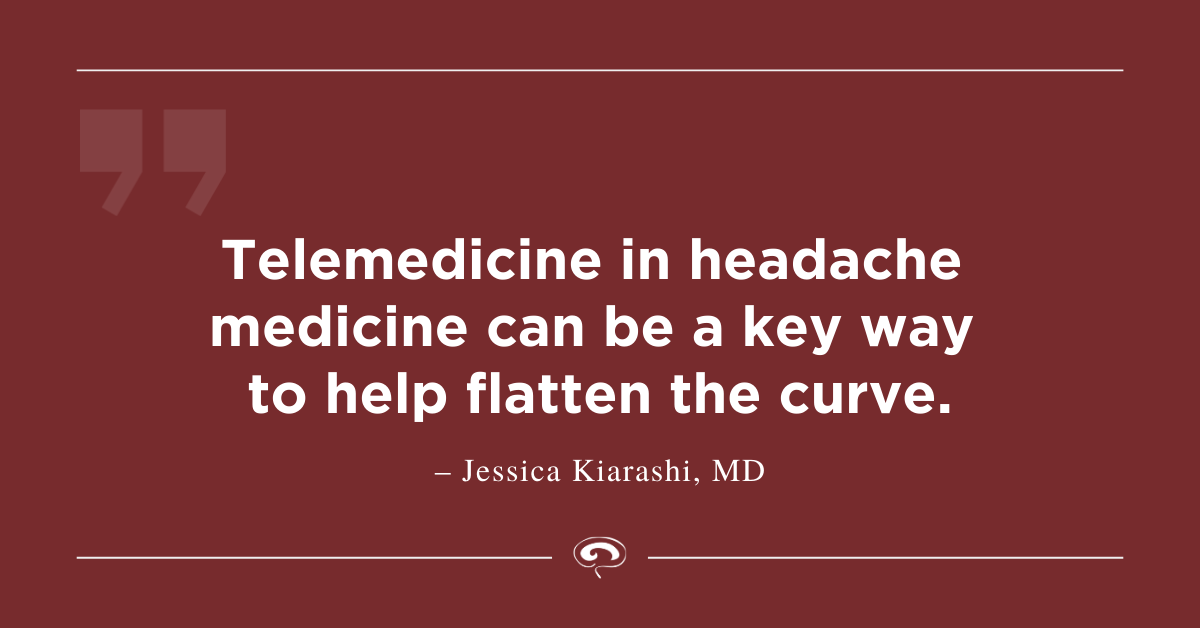
Telemedicine in the Age of the COVID-19 Pandemic
New insights about virtual care are especially relevant as hospitals face COVID-19 pandemic
An article recently published in Cephalalgia examines whether synchronous video-based telemedicine visits with specialists are feasible, and evaluates clinical effectiveness, patient perceptions, and other benefits of telemedicine visits for follow-up migraine care in a tertiary headache center.
“Telemedicine visits are beneficial to both patients and providers as they take less time to complete and provide more convenience to patients,” says Jessica Kiarashi, MD, a neurologist at The University of Texas Southwestern Medical Center, who spoke to AHS about the study. These types of consultations, she says, achieve the same or similar results as in-office visits and patients in fact appear to prefer them over in-office visits, especially considering they don’t need to travel and don’t need to take off from work. “Healthcare providers should be aware of these advantages offered by telemedicine and utilize it, especially in settings where access to providers is limited,” she says. Understanding the feasibility, ease, patient and provider satisfaction with telemedicine visits is of utmost importance at this time due to the COVID-19 pandemic and recommendations for social distancing.
Design and results
In this telemedicine study, after an initial visit, 45 patients were randomized to receive their follow-up care for one year by the same neurologist either in the office or by using telemedicine. Data were collected after each visit on criteria including headache disability, travel time and distance from the office, time missed from work, volume of communication between visits, perceptions of telemedicine and patient satisfaction. Willing participants were interviewed by telephone after the completion of the study about their experience. Data from enrollees completing at least one follow-up visit were included in the analysis.
Dr. Kiarashi says the design was a key aspect of the study. “I like that patients have their initial consultations face-to-face to introduce them to their provider and allow the provider the opportunity to examine them and assess whether secondary causes of headache need to be ruled out.” With this scenario, she says that patients felt comfortable continuing with telemedicine follow-ups once they’d been introduced to their provider. “Additionally, it is helpful that the same provider performs subsequent visits and that both video and audio are utilized as video makes for a more personal experience,” she notes.
Of the 30 participants who completed all visits, the outcomes were similar in both the in-office and telemedicine groups, while the average time for a visit—including travel—was 194 minutes for the in-office group, compared to 37 minutes in the telemedicine group. Overall satisfaction was higher in the telemedicine group, largely attributable to decreased travel time and less need to miss work.
Dr. Kiarashi says that the results are unsurprising. “I do think headache patients can be managed over telemedicine once they’ve been seen in initial consultation. However, while it makes sense that patients find these visits more convenient, I am surprised that so many patients in the telemedicine group reported such positive experiences, as my assumption was that they would prefer to meet face-to-face with their providers.” She believes this may be due to the study design, which gave patients a sense of connectedness to their providers as well as continuity.
Telemedicine provides an access solution in the age of COVID-19
Since well before the COVID-19 pandemic, access to healthcare has been an issue for many Americans who struggle with headache disorders, especially those not located near headache specialists. “I have patients who come from hours away and from different states to see me,” says Dr. Kiarashi. “It would be helpful to them if they had the option to do follow-ups through telemedicine and avoid having to drive, take flights, take off work and find child care in order to make in-office visits.”
Now, given the COVID-19 pandemic, telemedicine plays an even more important role in ensuring clinicians can manage patients from afar and protect themselves, other healthcare workers and other patients from potentially unnecessary exposures to the virus. “Given the current public health crisis, the safety of our patients and ourselves should be the main priority,” Dr. Kiarashi says. “When patients arrive at in-office appointments, they are exposed to the office elevators, waiting rooms and office counters. There are many points where they come into contact with other people and surfaces that could harbor the virus.”
The many opportunities for infection exposure can be reduced, she explains, through the employment of telemedicine. “We should help create social distance and relieve the pressure that is facing and will continue to face the healthcare system,” Dr. Kiarashi says. Telemedicine in headache medicine during the COVID-19 pandemic can be a key way to help “flatten the curve.”
Future steps
Dr. Kiarashi says that future research will be helpful to further bolster, support or refute findings on the topic, although ideally other papers will include similar careful design and keep in mind patient satisfaction. In the meantime, the results are acutely relevant in keeping the general population, not only headache patients, healthy.
“Our priorities going forward during this pandemic should include social distancing while providing access to care,” she says. Doing so, healthcare providers can remain healthy in order to serve patients virtually and, if needed, on the front lines. “The added bonus is that we can still provide optimal care as delineated by this article through telemedicine.”


